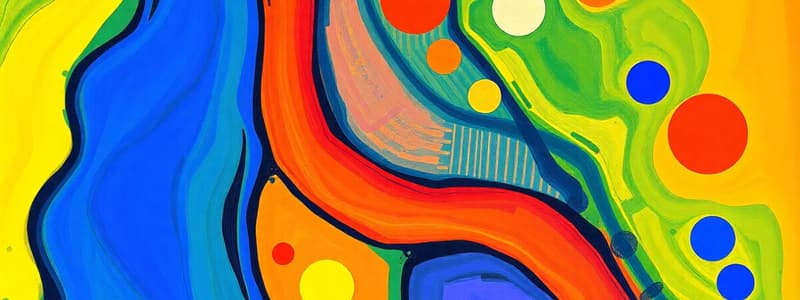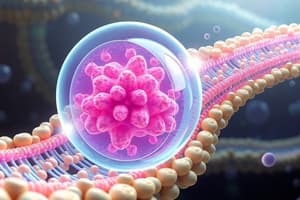Podcast
Questions and Answers
Which of the following are modes of transport through the cell membrane? (Select all that apply)
Which of the following are modes of transport through the cell membrane? (Select all that apply)
- Vesicular transport (correct)
- Osmosis (correct)
- Diffusion (correct)
- Carrier-mediated transport (correct)
- Active transport
What is osmosis?
What is osmosis?
The movement of water across a semipermeable membrane.
Define isotonic, hypotonic, and hypertonic.
Define isotonic, hypotonic, and hypertonic.
Isotonic: equal concentration; hypotonic: lower concentration than another solution; hypertonic: higher concentration than another solution.
Diffusion requires energy input from the cell.
Diffusion requires energy input from the cell.
What types of substances typically diffuse through the lipid bilayer?
What types of substances typically diffuse through the lipid bilayer?
What is one characteristic of the protein channels that affects selective permeability?
What is one characteristic of the protein channels that affects selective permeability?
The greater the thickness of the membrane, the ______ the rate of diffusion.
The greater the thickness of the membrane, the ______ the rate of diffusion.
What are gated channels? (Select all that apply)
What are gated channels? (Select all that apply)
Flashcards are hidden until you start studying
Study Notes
Membrane Transport
- Molecules can move across the plasma membrane by diffusion, osmosis, carrier-mediated transport, and vesicular transport
- Diffusion is the movement of molecules from an area of high concentration to an area of low concentration
- Diffusion doesn't require energy
Passive (Simple) Diffusion
- Lipid-soluble substances can diffuse through the lipid bilayer, moving from areas of high concentration to low concentration
- The rate of diffusion is directly proportional to the lipid solubility of the substance
- The rate of diffusion of substances through the lipid bilayer is also influenced by factors such as the size, charge, and shape of the molecule
- Water can also diffuse through the lipid bilayer due to its small size and lack of charge
- Lipid-insoluble substances can diffuse through the lipid bilayer if they are small enough, but the rate of diffusion decreases as the size of the molecule increases.
- Ions, even small ones, penetrate the lipid bilayer much less rapidly than water because they form hydrated ions with water and interact with the charges of the lipid bilayer.
Simple Diffusion Through Protein Channels
- Channels are classified based on their selective permeability to different molecules
- Factors that influence selective permeability include the channel diameter, shape, and the nature of the electrical charges lining its surface
- Channels can be classified based on their charges, with positively charged channels for negatively charged particles like chloride, negatively charged channels for positively charged particles, and uncharged channels for water (aquaporins)
- Channels can be classified based on the presence or absence of a gate, with leak channels continuously open and gated-channels having gates that open or close
- Gated channels are classified as voltage-gated, ligand-gated, or mechanically-gated
- The NMDA receptor is an exception, acting as both voltage-gated and ligand-gated
Factors that affect net rate of diffusion
- The permeability of the membrane is influenced by factors such as the thickness of the membrane, the lipid solubility of the substance, the number of protein channels, and the temperature
- Thicker membranes have slower rates of diffusion
- Higher lipid solubility equates to higher diffusion rates
- More channels result in faster diffusion
- Higher temperatures lead to faster diffusion rates
Studying That Suits You
Use AI to generate personalized quizzes and flashcards to suit your learning preferences.





